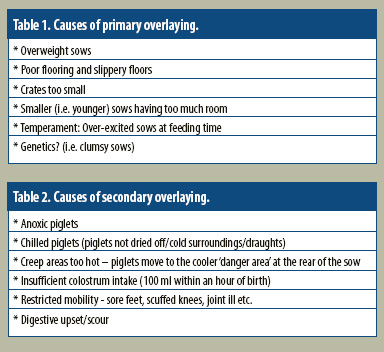What the textbooks don’t tell you about… Crushing

Reading a Nadis Health Bulletin about the subject of crushing, recently issued by BPEX in the UK, encouraged me to look through the pig textbooks on my shelves to see what they said about it. After all, Nadis reported that of losses to weaning reaching 12.45% on some farms, 6.66% were due to crushing. That caught my attention straightaway.
Several textbooks dealt with the subject, but rather superficially to my mind. So I turned to the veterinary tomes – to my surprise they were not much better.
A confession
Oh dear! I have not sufficiently covered crushing in my latest 600-page pig textbook – which should be in the bookshops soon. I should have done, as the problem seems a big one. A quick look through the subject seems therefore in order.
There are a host of reasons why piglets at and around suckling get overlain/trodden-on/kicked sideways. One cause must come high on the list, which none – not one, of the textbooks mention.
It must surely be…
Not being there at farrowing
Of course not everyone can make provision for this, even though the use of prostaglandins/oxytocin (applied correctly) helps considerably. Looking in my files, I see I have some before-and-after figures whose average suggests a reduction of 11% mortality to weaning to 8.5 % (1.24 piglets per litter down to 0.96 lost, or well over half a piglet more weaned sow/year). The manufacturers claim rather more than this.A few clients recently said that stillbirths rose slightly but this could be due to incorrect use – i.e. timing getting out of kilter. Pig-specialist veterinary supervision for the first few weeks of product use is a wise precaution, especially if oxytocin is used to ‘hurry-up’ those sows ‘holding off’ towards the end of the day shift. But I digress.
These larger sows
With the 240 days/135+ kg advice at first service catching on, these larger gilts of course become bigger sows later on. (By the way, don’t worry too much about the increased maintenance demand for food, as this is comfortably outweighed in economic terms by a much longer productive life).
I’ve been measuring farrowing crates at all the expos I visit and it seems that the industry is but slowly moving to bigger farrowing crates – some firms not at all, as two have not changed dimensions since 2003. Since then, a fourth parity sow could be 600 mm wider, 1,000 mm longer and 15 kg heavier at farrowing. Manufactures should bear this in mind and maybe think outside this particular box with variable-geometry designs – and the applied researchers could well look at the subject as well? On our Deans Grove farm we had smaller ‘gilt crates’ for young farrowers, which in those days were some 15-20 kg lighter at farrowing than they are today.
Bigger litters too
Thanks to genetic progress in the last decade, litters of 15 are not unusual. But birthing the litters of 13 or 15 piglets can take 20 minutes longer than the ones with 10 or 11 piglets we got eight years ago. Remember what the late Dr Peter English told us: “A piglet starts to die as soon as the birth process commences.” The tail-enders, starved of blood oxygen while waiting in the birth canal, arrive anoxic, therefore lethargic and slow to move out of harm’s way. As litter size increases, that is why being there at farrowing helps these last arrivals.
Primary and secondary crushing
The veterinary textbooks mention the above. Maybe semantics – but you should be aware of what they mean. ‘Primary overlaying’ is defined as affecting perfectly healthy piglets caused mainly by the sow, see Table 1. ‘Secondary overlaying’ occurs when the problem lies mainly with the piglets themselves, see Table 2.
And the likely cost of overlaying?
Nadis, through veterinarian Mark White has estimated this, saying that if the marginal cost of a newborn pig is £35 (in the UK; slightly less, about €40 in Europe) and based on as many as 0.66 pigs lost to crushing, this is a financial loss of 760 pigs to a 500-sow herd – which I suggest approaches €30,000. But I leave you to calculate your own figure; you will find it substantial. White claims this can be reduced by 60% – I calculate saving €36/sow/year.











